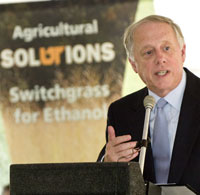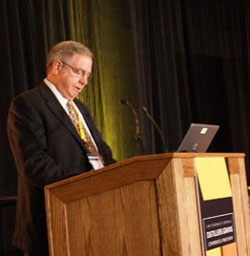While oil prices have been slashed by more than half since summertime highs of nearly $150 a barrel and gas prices have plummeted as well (hey, I’m not complaining about $2.40/gallon gas I just bought tonight), it’s no reason to let up on the drive to expand alternatives, such as ethanol and biodiesel.
 This story in the Chattanooga (TN) Times Free Press says a bipartisan group of 10 U.S. senators put together a compromise energy bill back in August, when $4 a gallon gas ruled and $200 a barrel oil loomed on the horizon. And even though the prices have fallen dramatically, and the group has expanded, they still are pushing for expansion of alternatives and dependence on foreign oil:
This story in the Chattanooga (TN) Times Free Press says a bipartisan group of 10 U.S. senators put together a compromise energy bill back in August, when $4 a gallon gas ruled and $200 a barrel oil loomed on the horizon. And even though the prices have fallen dramatically, and the group has expanded, they still are pushing for expansion of alternatives and dependence on foreign oil:
Still, members of the self-dubbed “Gang of 10,” which includes Sens. Bob Corker, R-Tenn.; Saxby Chambliss, R-Ga.; and Johnny Isakson, R-Ga.; say their proposal and focus on energy issues is no less important.
“I think energy will be the focus next year,” Sen. Corker said. “At the end of the day, we cannot lose sight of the fact that energy is important to us as an economic and a national security issue.”
The $84 billion Gang of 10 plan, now endorsed by 20 senators — 10 Democrats and 10 Republicans — includes increased offshore oil drilling and expanded tax credits for alternative fuels and technology…
“Electricity prices are going up, and gas prices may go back up,” said Sen. Lamar Alexander, R-Tenn., who has proposed a Manhattan Project-like energy plan. “Many people are as concerned about energy independence from unfriendly countries as they are about the price. Then we add to that the need for clean air.”
Sen. Alexander’s proposal includes developing plug-in hybrid cars whose owners could charge their cars from an electric outlet, saving significantly on fuel costs.
The plan also calls for improving solar energy capabilities, advancing nuclear energy, boosting biofuels, encouraging green buildings and funding nuclear fission research and carbon-capture technology.
The current credit crisis has also helped put the energy debate on the back burner, but members of the Gang of 10 promise they’ll bring it up again when the new Congress convenes in January.


 A new pilot plant that broke ground in Tennessee last week will be testing the use of switchgrass as a feedstock for cellulosic ethanol.
A new pilot plant that broke ground in Tennessee last week will be testing the use of switchgrass as a feedstock for cellulosic ethanol. Earlier in the day, Governor Bredesen participated in the state’s first-ever Summit on Clean Energy Technology in Knoxville. “When it comes to facing the challenges of the future, Tennessee isn’t just talking the talk about clean energy technology, we’re walking the walk, rolling up our sleeves and getting to work,” said Bredesen. “The bottom line is that this plant and this partnership are going to do a lot of good for Tennessee’s future.”
Earlier in the day, Governor Bredesen participated in the state’s first-ever Summit on Clean Energy Technology in Knoxville. “When it comes to facing the challenges of the future, Tennessee isn’t just talking the talk about clean energy technology, we’re walking the walk, rolling up our sleeves and getting to work,” said Bredesen. “The bottom line is that this plant and this partnership are going to do a lot of good for Tennessee’s future.” More than 1,700
More than 1,700 

 Biofuels in general and ethanol in particular were part of the discussion at the World Food Prize symposium in Des Moines this year. Despite the food versus fuel controversy that permeated the headlines for 2008, there seemed to be more acceptance of biofuels as being able to co-exist with food production and being part of the overall global agriculture picture.
Biofuels in general and ethanol in particular were part of the discussion at the World Food Prize symposium in Des Moines this year. Despite the food versus fuel controversy that permeated the headlines for 2008, there seemed to be more acceptance of biofuels as being able to co-exist with food production and being part of the overall global agriculture picture.  At the
At the  But in
But in 
 The first school district in the country to run its buses on biodiesel is celebrating 10 years of driving on the green fuel.
The first school district in the country to run its buses on biodiesel is celebrating 10 years of driving on the green fuel.